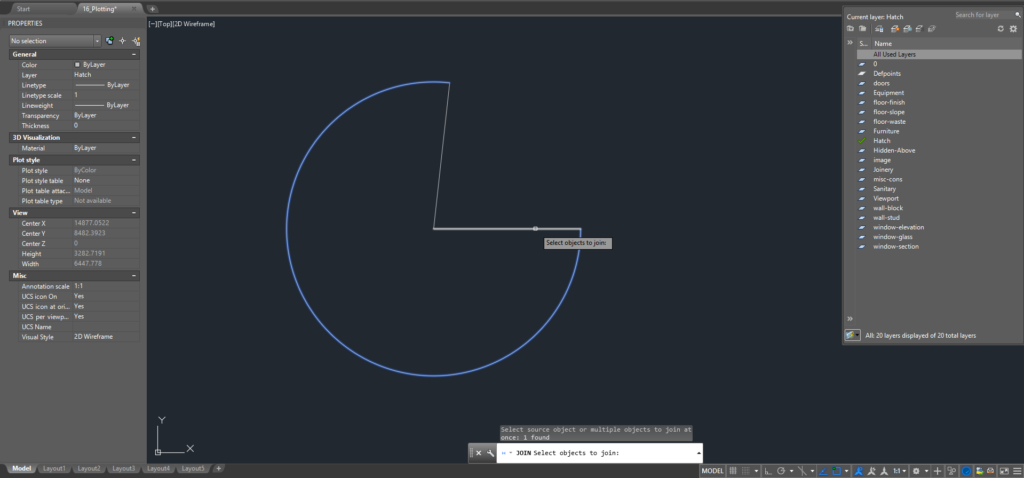Uniting Design Elements: A Comprehensive Guide to the Join Command in AutoCAD

Introduction:
AutoCAD, a pinnacle in the realm of computer-aided design (CAD), provides architects, engineers, and designers with a robust set of tools to transform concepts into precise drawings. Among these tools, the Join command stands out as a versatile feature that allows users to seamlessly connect and unite diverse design elements. This extensive article delves into the intricacies of the Join command in AutoCAD, exploring its functionalities, applications, and the transformative impact it has on achieving continuity and precision within the design process.
Understanding the Join Command in AutoCAD:
The Join command in AutoCAD is a powerful tool designed to connect and unite separate line or arc segments into a single, continuous polyline. This command plays a crucial role in enhancing the visual clarity and precision of drawings by eliminating gaps between adjacent elements. By creating a cohesive polyline, the Join command facilitates streamlined editing, manipulation, and analysis of design elements.
Key Features and Functionalities:
- Creating Continuous Polylines:
- The primary function of the Join command is to create continuous polylines from separate line or arc segments.
- By uniting these segments, designers can achieve a seamless and visually coherent representation of design elements.
- Eliminating Gaps and Discontinuities:
- Joining elements using this command eliminates gaps and discontinuities between adjacent line or arc segments.
- The result is a visually continuous and connected set of design elements, enhancing the overall precision and aesthetics of the drawing.
- Streamlining Editing and Modification:
- Continuous polylines created with the Join command offer streamlined editing and modification capabilities.
- Designers can manipulate the connected elements as a single entity, simplifying adjustments to length, orientation, or other properties.
- Maintaining Object Integrity:
- The Join command helps maintain the integrity of design elements by ensuring that they form a coherent whole.
- This is particularly valuable when dealing with drawings that require accurate representation, such as floor plans or detailed schematics.
Applications of the Join Command:
- Architectural Drawings and Floor Plans:
- In architectural drawings and floor plans, the Join command is instrumental in creating continuous outlines for walls, openings, and other architectural features.
- The elimination of gaps enhances the visual representation of the building layout.
- Electrical Schematics and Circuit Diagrams:
- Electrical schematics and circuit diagrams often involve intricate connections between components.
- The Join command facilitates the creation of continuous polylines, ensuring that circuit paths are accurately represented without gaps.
- Piping and HVAC Systems:
- In mechanical and HVAC drawings, the Join command aids in creating connected paths for piping systems.
- This ensures that the representation of pipes is visually cohesive, contributing to the accuracy of the design.
- Landscape Design and Site Plans:
- Landscape design and site plans benefit from the Join command when creating continuous outlines for paths, boundaries, and landscaping features.
- The seamless connection of elements enhances the overall presentation and clarity of the design.
Optimizing Workflow with the Join Command:
- Selecting and Joining Elements:
- To use the Join command, select the line or arc segments you want to connect.
- Access the Join command through the ribbon, toolbar, or by typing “JOIN” in the command line.
- Configuring Join Options:
- AutoCAD provides options within the Join command to configure settings such as the fuzz distance.
- The fuzz distance determines the maximum gap allowed for elements to be joined. Understanding and adjusting this setting ensures accurate results.
- Batch Joining with Scripts:
- For users dealing with multiple line or arc segments, especially in large drawings, AutoLISP scripts can be employed to automate the Join command.
- Custom scripts can streamline the process and enhance efficiency in batch joining.
- Verifying Results and Object Properties:
- After using the Join command, it is advisable to verify the results by zooming in on the connected elements.
- Check object properties to ensure that the joined elements form a single polyline with the desired characteristics.
Conclusion:
In conclusion, the Join command in AutoCAD is a pivotal tool for designers seeking continuity, precision, and visual coherence in their drawings. Whether creating architectural outlines, representing electrical circuits, detailing piping systems, or designing landscapes, the Join command offers a streamlined approach to connecting and unifying diverse design elements. As AutoCAD continues to evolve, the emphasis on features like the Join command reflects the software’s commitment to providing users with tools that transcend traditional drafting boundaries. Embrace the power of the Join command, and witness the transformation of your AutoCAD experience into a journey of continuity, precision, and creative exploration within the vast landscape of CAD design.




